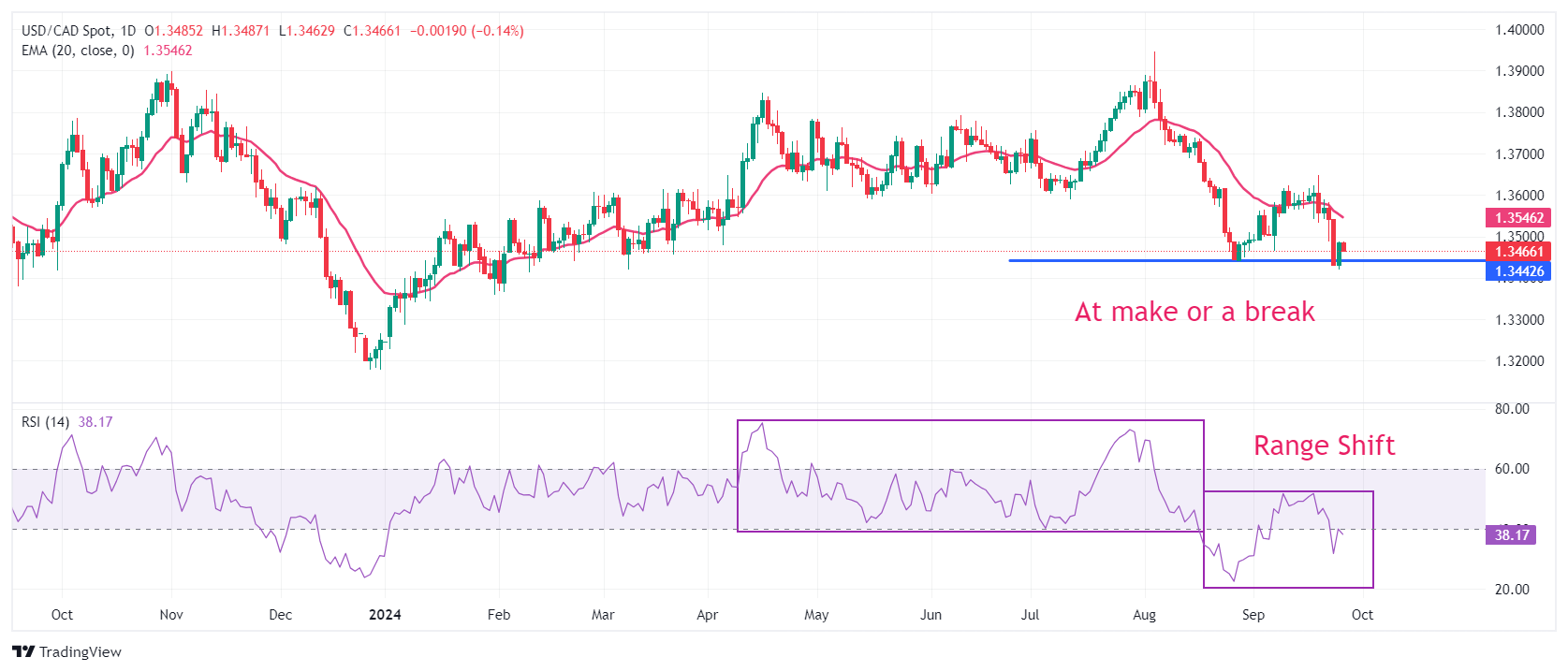USD/CAD Price Forecast: Trades at make or a break near 1.3450
- USD/CAD falls slightly ahead of the Fed Powell’s speech.
- Investors look for fresh interest rate cues for the November meeting.
- The Canadian economy is estimated to have barely grown in July.
The USD/CAD pair edges lower to near 1.3465 in Thursday’s European session after a strong recovery on Wednesday. The Loonie asset faces a mild sell-off as the US Dollar (USD) struggles to extend recovery, with the US Dollar Index (DXY) facing pressure near 101.00.
The next move in the US Dollar will be guided by Fed Chair Jerome Powell’s speech at 13:20 GMT in which he is expected to provide fresh guidance on interest rates. In last week’s press conference after the policy decision of interest rate reduction by 50 basis points (bps) to 4.75%-5.00%, the comments from Jerome Powell suggested that the larger-than-usual rate cut will not be the new normal.
On the contrary, the probability of the Fed delivering another 50 bps interest rate cut in November is 61%, higher than 39% a week ago, according to the CME FedWatch tool.
Meanwhile, the Canadian Dollar (CAD) will be influenced by the monthly Gross Domestic Product (GDP) data for July, which will be published on Friday. Economists estimate the Canadian economy to have grown by 0.1% after remaining flat in June.
USD/CAD prints a fresh swing low near 1.3400 on a daily timeframe, suggesting a firm bearish trend. The Loonie asset weakens after slipping below the August 28 low of 1.3440. A declining 20-day Exponential Moving Average (EMA) near 1.3545 indicates more downside.
The 14-day Relative Strength Index delivers a range shift move into the 20.00-60.00 territory from 40.00-80.00, which suggests that pullbacks would be considered as selling opportunities by investors.
Going forward, a further correction by the major below the immediate support of 1.3400 would expose it to January 31 low of 1.3360 and June 9 low of 1.3340.
In an alternate scenario, a recovery move above the psychological support of 1.3500 would drive the asset towards April 5 low of 1.3540, followed by September 20 high of 1.3590.
USD/CAD daily chart
Canadian Dollar FAQs
The key factors driving the Canadian Dollar (CAD) are the level of interest rates set by the Bank of Canada (BoC), the price of Oil, Canada’s largest export, the health of its economy, inflation and the Trade Balance, which is the difference between the value of Canada’s exports versus its imports. Other factors include market sentiment – whether investors are taking on more risky assets (risk-on) or seeking safe-havens (risk-off) – with risk-on being CAD-positive. As its largest trading partner, the health of the US economy is also a key factor influencing the Canadian Dollar.
The Bank of Canada (BoC) has a significant influence on the Canadian Dollar by setting the level of interest rates that banks can lend to one another. This influences the level of interest rates for everyone. The main goal of the BoC is to maintain inflation at 1-3% by adjusting interest rates up or down. Relatively higher interest rates tend to be positive for the CAD. The Bank of Canada can also use quantitative easing and tightening to influence credit conditions, with the former CAD-negative and the latter CAD-positive.
The price of Oil is a key factor impacting the value of the Canadian Dollar. Petroleum is Canada’s biggest export, so Oil price tends to have an immediate impact on the CAD value. Generally, if Oil price rises CAD also goes up, as aggregate demand for the currency increases. The opposite is the case if the price of Oil falls. Higher Oil prices also tend to result in a greater likelihood of a positive Trade Balance, which is also supportive of the CAD.
While inflation had always traditionally been thought of as a negative factor for a currency since it lowers the value of money, the opposite has actually been the case in modern times with the relaxation of cross-border capital controls. Higher inflation tends to lead central banks to put up interest rates which attracts more capital inflows from global investors seeking a lucrative place to keep their money. This increases demand for the local currency, which in Canada’s case is the Canadian Dollar.
Macroeconomic data releases gauge the health of the economy and can have an impact on the Canadian Dollar. Indicators such as GDP, Manufacturing and Services PMIs, employment, and consumer sentiment surveys can all influence the direction of the CAD. A strong economy is good for the Canadian Dollar. Not only does it attract more foreign investment but it may encourage the Bank of Canada to put up interest rates, leading to a stronger currency. If economic data is weak, however, the CAD is likely to fall.

